英语语法之特殊句式
- 格式:pdf
- 大小:16.25 KB
- 文档页数:6
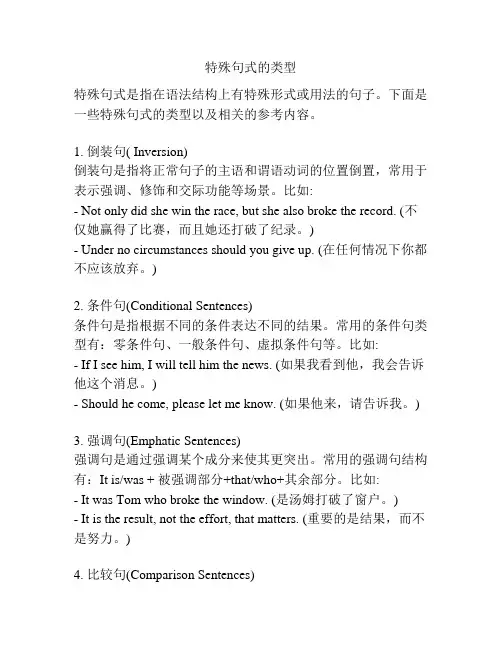
特殊句式的类型特殊句式是指在语法结构上有特殊形式或用法的句子。
下面是一些特殊句式的类型以及相关的参考内容。
1. 倒装句( Inversion)倒装句是指将正常句子的主语和谓语动词的位置倒置,常用于表示强调、修饰和交际功能等场景。
比如:- Not only did she win the race, but she also broke the record. (不仅她赢得了比赛,而且她还打破了纪录。
)- Under no circumstances should you give up. (在任何情况下你都不应该放弃。
)2. 条件句(Conditional Sentences)条件句是指根据不同的条件表达不同的结果。
常用的条件句类型有:零条件句、一般条件句、虚拟条件句等。
比如:- If I see him, I will tell him the news. (如果我看到他,我会告诉他这个消息。
)- Should he come, please let me know. (如果他来,请告诉我。
)3. 强调句(Emphatic Sentences)强调句是通过强调某个成分来使其更突出。
常用的强调句结构有:It is/was + 被强调部分+that/who+其余部分。
比如:- It was Tom who broke the window. (是汤姆打破了窗户。
)- It is the result, not the effort, that matters. (重要的是结果,而不是努力。
)4. 比较句(Comparison Sentences)比较句是用来比较两个对象或者描述相对关系的句子。
常用的比较句结构有:as+adj./adv. +as, not as+adj./adv.+as,more/less+adj./adv.+ than等。
比如:- He runs as fast as a cheetah. (他跑得像一只猎豹一样快。
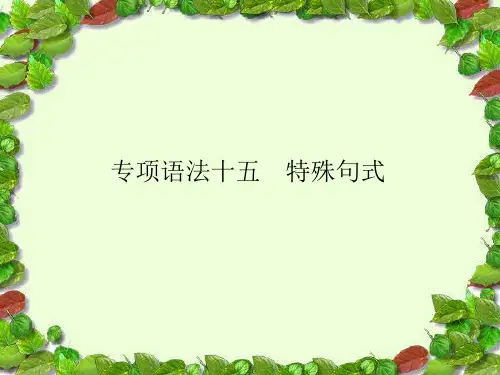
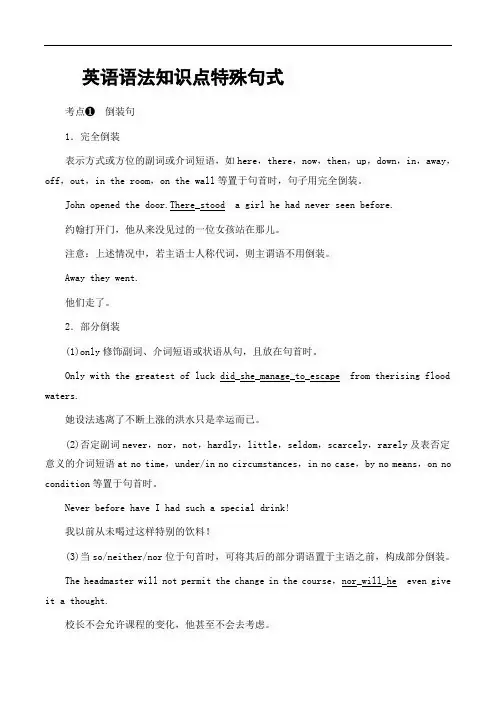
英语语法知识点特殊句式考点❶倒装句1.完全倒装表示方式或方位的副词或介词短语,如here,there,now,then,up,down,in,away,off,out,in the room,on the wall等置于句首时,句子用完全倒装。
约翰打开门,他从来没见过的一位女孩站在那儿。
注意:上述情况中,若主语士人称代词,则主谓语不用倒装。
Away they went.他们走了。
2.部分倒装(1)only修饰副词、介词短语或状语从句,且放在句首时。
waters.她设法逃离了不断上涨的洪水只是幸运而已。
(2)否定副词never,nor,not,hardly,little,seldom,scarcely,rarely及表否定意义的介词短语at no time,under/in no circumstances,in no case,by no means,on no condition等置于句首时。
Never before have I had such a special drink!我以前从未喝过这样特别的饮料!(3)当so/neither/nor位于句首时,可将其后的部分谓语置于主语之前,构成部分倒装。
it a thought.校长不会允许课程的变化,他甚至不会去考虑。
(4)hardly...when...,no sooner...than...,not only...but also...等连接两个句子且hardly,no sooner,not only位于句首时,前一个句子用部分倒装,后一个句子不倒装。
The computer was used in teaching.As a result,not only电脑被应用于教学中。
结果,不仅节省了老师的精力,学生也对课堂更感兴趣了。
(5)在so...that...和such...that...句式中,如果so或such引导的部分位于句首时,他取得了如此大的进步以至于受到了表扬。
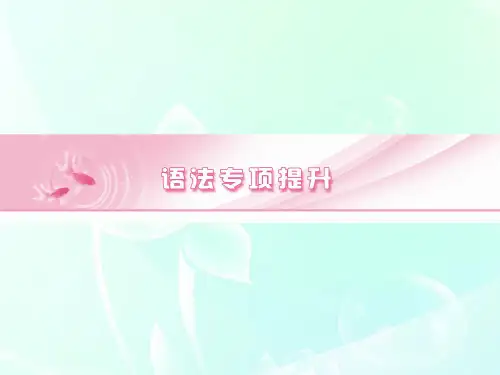
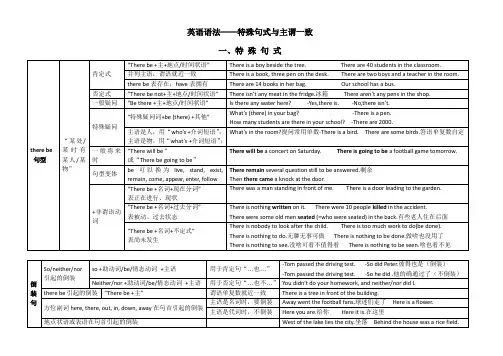
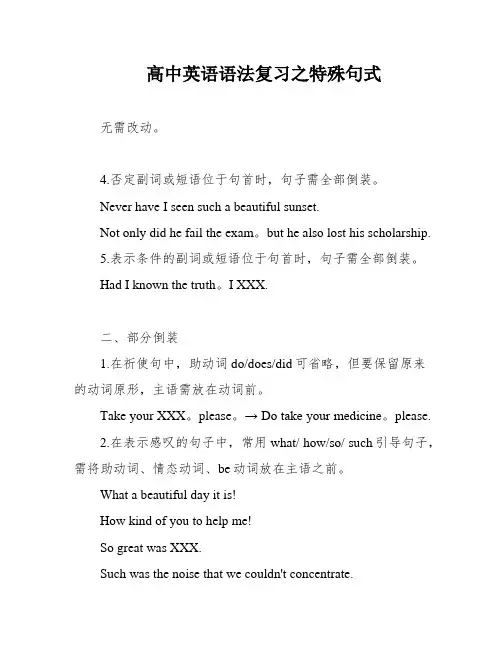
高中英语语法复习之特殊句式无需改动。
4.否定副词或短语位于句首时,句子需全部倒装。
Never have I seen such a beautiful sunset.Not only did he fail the exam。
but he also lost his scholarship.5.表示条件的副词或短语位于句首时,句子需全部倒装。
Had I known the truth。
I XXX.二、部分倒装1.在祈使句中,助动词do/does/did可省略,但要保留原来的动词原形,主语需放在动词前。
Take your XXX。
please。
→ Do take your medicine。
please.2.在表示感叹的句子中,常用what/ how/so/ such引导句子,需将助动词、情态动词、be动词放在主语之前。
What a beautiful day it is!How kind of you to help me!So great was XXX.Such was the noise that we couldn't concentrate.C.强调句强调句是指在句子中通过特殊的语法结构来强调某一成分,使其更加突出。
1.强调句的结构:It is/was + 被强调部分 + that/who + 其他成分。
It was Tom who won the first prize.It XXX.2.强调句中被强调部分的形式:可以是名词、代词、形容词、副词、动词、介词短语等。
It was the best movie I have ever seen.It is only with hard work that you can achieve success.3.强调句的注意事项:强调句中的被强调部分通常放在句首或句末。
强调句中的谓语动词要与其主语保持一致。
强调句中的that/who可以省略,但要注意谓语动词的变化。
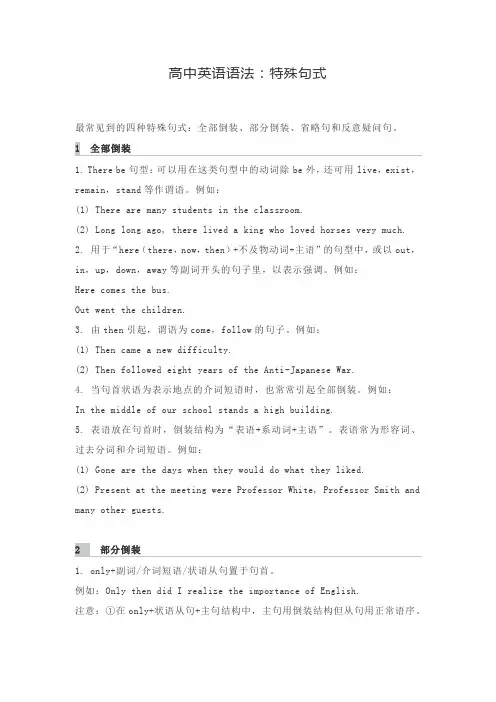
高中英语语法:特殊句式最常见到的四种特殊句式:全部倒装、部分倒装、省略句和反意疑问句。
1 全部倒装1. There be句型:可以用在这类句型中的动词除be外,还可用live,exist,remain,stand等作谓语。
例如:(1) There are many students in the classroom.(2) Long long ago, there lived a king who loved horses very much.2. 用于“here(there,now,then)+不及物动词+主语”的句型中,或以out,in,up,down,away等副词开头的句子里,以表示强调。
例如:Here comes the bus.Out went the children.3. 由then引起,谓语为come,follow的句子。
例如:(1) Then came a new difficulty.(2) Then followed eight years of the Anti-Japanese War.4. 当句首状语为表示地点的介词短语时,也常常引起全部倒装。
例如:In the middle of our school stands a high building.5. 表语放在句首时,倒装结构为“表语+系动词+主语”。
表语常为形容词、过去分词和介词短语。
例如:(1) Gone are the days when they would do what they liked.(2) Present at the meeting were Professor White, Professor Smith and many other guests.2 部分倒装1. only+副词/介词短语/状语从句置于句首。
例如:Only then did I realize the importance of English.注意:①在only+状语从句+主句结构中,主句用倒装结构但从句用正常语序。

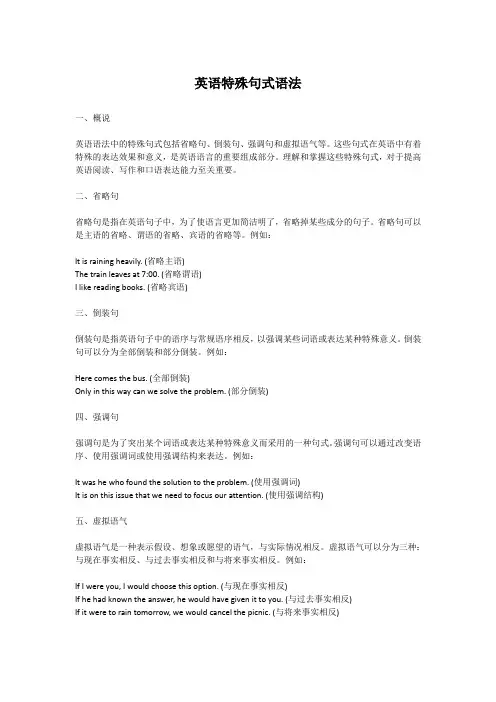
英语特殊句式语法一、概说英语语法中的特殊句式包括省略句、倒装句、强调句和虚拟语气等。
这些句式在英语中有着特殊的表达效果和意义,是英语语言的重要组成部分。
理解和掌握这些特殊句式,对于提高英语阅读、写作和口语表达能力至关重要。
二、省略句省略句是指在英语句子中,为了使语言更加简洁明了,省略掉某些成分的句子。
省略句可以是主语的省略、谓语的省略、宾语的省略等。
例如:It is raining heavily. (省略主语)The train leaves at 7:00. (省略谓语)I like reading books. (省略宾语)三、倒装句倒装句是指英语句子中的语序与常规语序相反,以强调某些词语或表达某种特殊意义。
倒装句可以分为全部倒装和部分倒装。
例如:Here comes the bus. (全部倒装)Only in this way can we solve the problem. (部分倒装)四、强调句强调句是为了突出某个词语或表达某种特殊意义而采用的一种句式。
强调句可以通过改变语序、使用强调词或使用强调结构来表达。
例如:It was he who found the solution to the problem. (使用强调词)It is on this issue that we need to focus our attention. (使用强调结构)五、虚拟语气虚拟语气是一种表示假设、想象或愿望的语气,与实际情况相反。
虚拟语气可以分为三种:与现在事实相反、与过去事实相反和与将来事实相反。
例如:If I were you, I would choose this option. (与现在事实相反)If he had known the answer, he would have given it to you. (与过去事实相反)If it were to rain tomorrow, we would cancel the picnic. (与将来事实相反)六、总结英语特殊句式语法是英语语言的重要组成部分,理解和掌握这些特殊句式对于提高英语阅读、写作和口语表达能力至关重要。
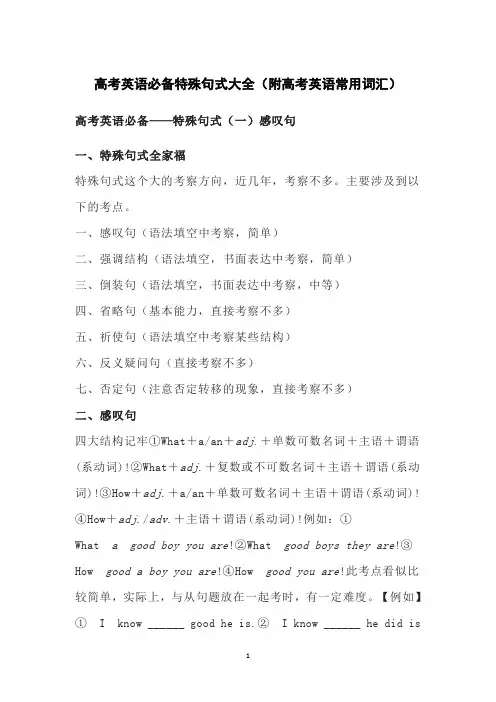
高考英语必备特殊句式大全(附高考英语常用词汇)高考英语必备——特殊句式(一)感叹句一、特殊句式全家福特殊句式这个大的考察方向,近几年,考察不多。
主要涉及到以下的考点。
一、感叹句(语法填空中考察,简单)二、强调结构(语法填空,书面表达中考察,简单)三、倒装句(语法填空,书面表达中考察,中等)四、省略句(基本能力,直接考察不多)五、祈使句(语法填空中考察某些结构)六、反义疑问句(直接考察不多)七、否定句(注意否定转移的现象,直接考察不多)二、感叹句四大结构记牢①What+a/an+adj.+单数可数名词+主语+谓语(系动词)!②What+adj.+复数或不可数名词+主语+谓语(系动词)!③How+adj.+a/an+单数可数名词+主语+谓语(系动词)!④How+adj./adv.+主语+谓语(系动词)!例如:①What a good boy you are!②What good boys they are!③How good a boy you are!④How good you are!此考点看似比较简单,实际上,与从句题放在一起考时,有一定难度。
【例如】①I know ______ good he is.②I know ______ he did isgood.在①中,答案为how,how good he is 是一个how 引导的感叹句;在②中,答案为what,what he did is good 是一个what引导的宾语从句问题来了,如何区分how,what引导的是感叹句还是从句呢?【答案】四个字,句!子!结!构!如宾语或者主语,或者表语;how引导的,其后是一个符合五大基本结构完整的句子。
【经典考察】(1)(2015年新课标卷Ⅱ)As natural architects, the Pueblo Indians figured out exactly ______(70) thick the adobe walls needed to be to make the cycle work on most days.【答案】how;how thick the adobe needed to be符合④How+adj./adv.+主语+谓语(系动词)!结构,故填how;(2)(2021年河南省天一联考)I recently spent a day in Hangzhou to see ______(65) easy it was to go cashless, and I found it somewhat ahead of other cities , including Beijing. I rode buses and subways, which all accept Alipay.【答案】how;how easy it is符合④How+adj./adv.+主语+谓语(系动词)! 结构,故填how;此外,初中的恶人搭配要记牢!how long;how soon;how far;how often;how many;how much【例】how long did he stay here?他在这里呆了多久How long is the river?这条河有多长?How often does he come here?他多久来这里一次?How soon will he be back?他多久之后会回来?How far is it from here to there?从这里到那里有多远。
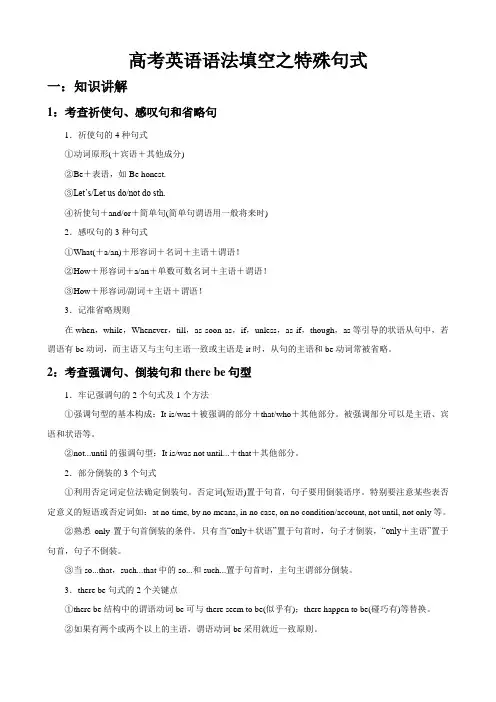
高考英语语法填空之特殊句式一:知识讲解1:考查祈使句、感叹句和省略句1.祈使句的4种句式①动词原形(+宾语+其他成分)②Be+表语,如Be honest.③Let’s/Let us do/not do sth.④祈使句+and/or+简单句(简单句谓语用一般将来时)2.感叹句的3种句式①What(+a/an)+形容词+名词+主语+谓语!②How+形容词+a/an+单数可数名词+主语+谓语!③How+形容词/副词+主语+谓语!3.记准省略规则在when,while,Whenever,till,as soon as,if,unless,as if,though,as等引导的状语从句中,若谓语有be动词,而主语又与主句主语一致或主语是it时,从句的主语和be动词常被省略。
2:考查强调句、倒装句和there be句型1.牢记强调句的2个句式及1个方法①强调句型的基本构成:It is/was+被强调的部分+that/who+其他部分。
被强调部分可以是主语、宾语和状语等。
②not...until的强调句型:It is/was not until...+that+其他部分。
2.部分倒装的3个句式①利用否定词定位法确定倒装句。
否定词(短语)置于句首,句子要用倒装语序。
特别要注意某些表否定意义的短语或否定词如:at no time, by no means, in no case, on no condition/account, not until, not only等。
②熟悉only置于句首倒装的条件。
只有当“only+状语”置于句首时,句子才倒装,“only+主语”置于句首,句子不倒装。
③当so...that,such...that中的so...和such...置于句首时,主句主谓部分倒装。
3.there be句式的2个关键点①there be结构中的谓语动词be可与there seem to be(似乎有);there happen to be(碰巧有)等替换。
英语特殊句式语法英语语法中存在一些特殊的句式结构,它们具有独特的语法规则和用法。
在本文中,我们将介绍一些常见的英语特殊句式,并通过示例来解释它们的用法。
一、倒装句倒装句是英语中常见的特殊句式之一,它采取了主语和谓语动词的位置颠倒。
倒装句的用法多种多样,下面是一些常见的情况:1. 完全倒装:当句子以表示地点状态的副词(如here, there, now, then等)开头时,需要完全倒装。
例如:Here comes the bus.There goes my hat.2. 部分倒装:在某些特定的条件下,主语和谓语动词的位置需要部分颠倒。
a. 在用于表示否定的副词或短语(如never, seldom, hardly, not until 等)开头的句子中,需要将助动词或情态动词与主语颠倒。
例如:Never have I seen such a beautiful sunset.Not until she left did I realize how much I loved her.b. 在以表示条件的状语从句(如if, unless, whether等)开头的句子中,需将助动词和主语颠倒。
例如:If only I had more time, I would travel around the world.Whether it rains or not, we will go camping.二、虚拟语气虚拟语气是英语中常见的特殊句式之一,用于表示与事实相反、假设或愿望等情况。
以下是虚拟语气的几种常见形式:1. 虚拟条件句:用于表示与事实相反的假设情况,包括类型1、类型2和类型3三种类型。
a. 类型1:表示真实可能发生的假设例如:If she studies hard, she will pass the exam.b. 类型2:表示与事实相反,但在理论上有可能实现的假设例如:If I were you, I would quit that job.c. 类型3:表示与过去事实相反的假设例如:If I had studied harder, I would have passed the exam.2. 虚拟表达愿望例如:I wish I could play the piano like a professional.3. 虚拟表达建议、命令等例如:The teacher suggested that they should review the material again.三、强调句强调句是一种特殊的句式,它通过强调句子中的某个成分来表达特殊的意义。
特殊句式的结构1.It结构一、强调句强调句的基本句型是“It is/was+被强调的部分+that/who+其他部分”。
被强调的部分可以是主语、宾语和状语等。
强调句型的使用特点主要有以下几个方面:(1)被强调的是状语或状语从句时,要用that引导从句,而不能用which,而且通常不能省略。
(2)被强调的是人时,引导词可用who,也可用that。
Was it you that/who let out the secret to her?是你把这个秘密泄露给她的吗?(3)被强调的不管是单数还是复数名词,主句的be动词都用单数is或was。
It was Marie Curie and her husband who discovered radium.是居里夫人和她的丈夫发现了镭。
It is the PLA men who/that are safeguarding our country day and night.是解放军战士日夜保卫着我们的祖国。
(4)对not...until时间状语从句进行强调时,其句型是:It is/was not until...that从句,即not和until在强调句中总是紧挨着的。
注意习惯上不用not till,而且从句不能用when引导。
It was not until the last operation was finished that Bethune left the battle hospital.(5)强调句的疑问形式:When was it that he made up his mind to take this course?他是什么时候决定选修这一门课程的?Why is it that he doesn’t like th e book?他为什么不喜欢这本书?Was it in 1939 that the Second World War broke out?(6)强调句型与It is/was+时间+when从句:在上述句型中it指时间,when引导的是时间状语从句。
特殊句式I There beA 定义表达“某处/某时存在某人/某物”。
B 结构一般结构:There + be + 名词+ 地点将来结构:There will be + 名词+ 地点完成结构:There has been + 名词+ 地点含情态动词结构:There + 情态动词+ be + 名词+地点C 用法a. 就近原则例:There is some juice and some cakes on the table.b. 衍生结构①There be + 名词+ doing(与名词形成主动关系)例:There must be something blocking the pipe.②There be + 名词+ done(与名词形成被动关系)例:T here’s only four days left.③There be + 名词+ to do(未发生,表将要做…)例:There is still a lot of work for me to do.拓展:there be句型中,其结构中谓语动词和非谓语结构的变化·there be中的be有时可用seem to be,happen to be,is likely to be或go,remain,stand,lie,exist,follow,live,come,occur等替换例:There existed different opinions on this problem.·there be结构的非谓语形式:there to be 和there being。
there to be结构可用作动词的宾语,也可用作介词for的宾语;there being可用作除for外的介词宾语或状语例:I expect there to be no argument about this.(作宾语)I have never dreamed of there being a chance to go abroad.(作宾语)There being no enough time left, we have to hurry.(独立主格结构作状语)注:·跟动名词的动词后用there being,常见的有:deny,mind,admit,imagine等·跟不定式的动词后用there to be,常见的动词有:expect,want,hope,wish,like,hate,would like,prefer,mean,intend等c. 固定句型①There is no point/sense (in) doing sth “做某事没意义”例:There is no point/sense arguing further.②There is no doubt that…“毫无疑问…”例:There is no doubt that the new technology is changing the way we work.③There is no need to do sth “没必要做某事“例;There is no need to get up early tomorrow.④There is no possibility/ chance that…“……是不可能的”例:There is no chance that he will change his mind.⑤There is no denying (the fact) that…“不可否认……”例:There is no denying (the fact) that our life has gone from bad to worse.⑥There is no difficulty/ trouble in doing sth“作某事没困难”例:There is no trouble in solving the problem.d. 区分:there be 和have①there be与have都可表示“有”,但在意义上,have表示所有关系,即“拥有”,there be则表示“客观存在”。